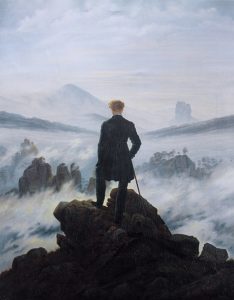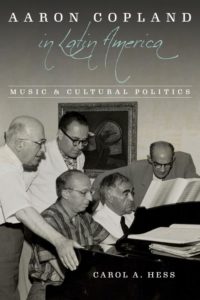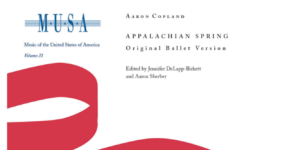
Aaron Copland and the Legacy of Gustav Mahler by Matthew Mugmon is illuminating, thought provoking and at times frustrating. Its thesis is that America’s Composer Aaron Copland was influenced by the romanticism and neo classicism of Gustav Mahler throughout his career and that the American sound so associated with Copland does not just have its origin in the salons of Paris (as conventional wisdom suggests) but also in the romantic era. As Mahler’s music bridged the gap between romanticism and modernism and his music was championed by Copland, Nadia Boulanger (at least initially) and Leonard Bernstein he is seen as the chief protagonist. Mugmon illustrates his viewpoint with evidence from letters, newspaper articles, books and lecture notes from Copland’s time as a student in New York and Paris, as a teacher, as a mentor, as an influencer, in his own compositions and during his own later forays as a conductor.
It’s a very interesting argument. The book is well researched and the detail is forensic in the extreme. It is certainly a very welcome addition to academic treatments of Copland’s life and works as it fills a void that has not really been dealt with in the past. Despite Copland’s interest and obvious fondness for Mahler the other key reference books on Copland (Aaron Copland – The Life and Work of an Uncommon Man by Howard Pollack and Copland’s autobiographies Aaron Copland 1900-1942 and Copland since 1943, both with Vivian Perlis) really do not give any musical relationship much consideration in the way of column inches. Therefore, it is fascinating to speculate what Copland would have thought of this book himself?
Of course the evidence for Mugmon’s case is preserved in Copland’s writings. The most notable of these was Copland’s long letter to the New York Times in 1925 where he went head on against the many notable critics and their scathing reviews. The letter is oddly not reproduced in full (one needs to read Aaron Copland – A reader Selected writings 1923 – 1972 for that) but one can glean the boyish enthusiasm that the music of Gustav Mahler invokes in Copland. Yet one must remember this was a 25 year old writing. I recently saw an interview with Copland from 1973 (see YouTube clip below) in which the interviewer begins by paraphrasing Copland’s own words “When something gets between quotation marks somehow its forever the truth even though circumstances change”.
And it is clear that Copland’s view on Gustav Mahler did change. In fact it seems to have waxed and waned considerably down the years. Despite Copland’s eagerness to praise Mahler as a proto modernist who introduced new methods of counterpoint and orchestration, virtually every utterance is tempered by Copland’s view of Mahler’s downsides. In addition, in comparing Mahler to the greats Copland is responsible for some brilliant quotes– which can only be considered back handed compliments. As a result it often seems that although Copland is admitting that he likes Mahler, it’s almost as if he’s conceding to a guilty pleasure rather than stance he is 100% committed to.
“Every page he wrote has that individual quality that we demand from every great composer – he was never more Mahler than when he was copying Mozart”1925
“…(Mahler) has at times written music which is bombastic, long winded, banal……If one discounts for the moment the banal themes, the old fashioned romantico-philosophical considerations so dear to Mahler-if one looks at the music qua music – then it is undeniable that Mahler is a composer of today”1925
“Once Mahler’s significance is grasped, the world will make light of his apparent weaknesses, his banalities, his longueurs. To make his art better known should be the desire of every artist”. 1931
“One is always being told that Mahler was no Beethoven. Quite so. The difference between Beethoven and Mahler is the difference between watching a great man walk down the street and watching a great actor act the part of a great man walking down the street. The two experiences can be equally impressive, though in different ways”. 1941
Mugmon is a fine sleuth and has turned up some fantastic new insights and certainly will make me listen to certain Copland works in a different way. I particularly enjoyed reading about Copland’s first composition teacher, Rubin Goldmark and his guarded interest in Mahler. Most writing on Copland is completely influenced by Copland’s own narrative that Goldmark was a conservative and had no interest in modern music. As a result, Goldmark often is portrayed as a stuffy and dull comformist, thwarting the modernist inclinations of the young Copland which were only fully unleased when he became the pupil of Nadia Boulanger. Mugmon’s appraisal gives a different perspective painting Goldmark in a much more favourable light.
Similarly, the chapter involving Copland’s years in Paris with Boulanger are also intriguing. It’s really interesting to read about her change in opinion on Mahler through the decades. She actively encouraged Copland to defend Mahler’s music in the 20s but this later changed to disapproval of other students who expressed an interest in Mahler in the post war years. Despite this cooling in public attitude it is fascinating to learn that she was still buying Mahler scores as late as 1959!
My frustrations in the book are some of the avenues that haven’t been explored. For instance, a lot is made of the similarity of the endings of a couple of works (Music for the Theatre and Appalachian Spring with that of Das Lied von der Erde and the 9th Symphony) but very little is made of the enormous differences between Copland and Mahler. It is true that “Copland’s music like Mahler’s is both bombastic and delicate, grandiose and modest, romantic and modern” but Mahler’s works tend to be gargantuan in size of orchestra and length (many well over an hour) whereas in Copland’s oeuvre the forces tends to be much more modest and concise. Very few works are for large orchestra (Symphonic Ode, 3rd Symphony, Connotations) and even these large works tend to be short, Symphony No 3 is uncharacteristically long for a Copland work at 40+ minutes. Most other “large” scale orchestral works are around 20 minutes. I would have loved a comparison Copland’s 2nd Symphony (Short Symphony) of 15 minutes with Mahler’s 2nd Symphony “The Resurrection”. The two works could not be more different and are definitive works for both. As a result it does feel that the requirement to find similarities means that the very obvious differences are overlooked.

Wanderer above the Sea of Fog by Caspar David Friedrich (1818)
It seems obvious that Copland was influenced musically by Mahler. However, like all composers (including Mahler) they all were standing on the shoulders of giants. I certainly can see similarities in the ending of Appalachian Spring and Das Lied von der Erde. In both pieces there is no doubt the “voice of solitary contemplation”. However, in my view I think the link between the two works is somewhat overstated. The painter Caspar David Friedrich had visualized a Wanderer above the Sea of Fog, a lone man on the top of the mountain surveying the shrouded landscape in front of him as early as 1818. As a result, this strong silent type, the outsider looking beyond, almost into another world was already a common romantic theme long before Mahler and with the advent of the moving picture this symbolism became very mainstream. Even prior to Appalachian Spring there were cowboys walking off into the sunset! In fact Copland had frequently used ambiguous, slow endings not only in Music for the Theatre but also Quiet City, Statements and Billy the Kid. Appalachian Spring just happens to be the most sublime incarnation of this.
The other inference that doesn’t sit right for me is the idea that Copland’s use of Simple Gifts relates to Mahler’s use of folk material in his 1st Symphony. So many composers of Copland’s time and before were mining folk tunes – Bartok, Kodaly, Vaughn Williams, Virgil Thompson etc. And what’s more the work of Alan Lomax bringing folk material to the Library of Congress made it inevitable that Copland would use these sources. Besides Copland had already used folk tunes in Billy the Kid and Rodeo. This argument is uncharacteristically a bit thin.
Another interesting perspective that is not explored is that to me it seems odd that Copland even liked let alone loved some of Mahler’s extended pieces. When I read that Copland included the final of the 9th Symphony as one of the Mahler pieces that is truly great I was surprised. For someone so proud to not waste notes and to get a musical point across succinctly, who described Vaughan Williams 5th Symphony as “like watching a cow for 45 minutes” it seems out of character. For me, this is something that cannot be explained – simply the paradox of personal taste.
In Chapter 6 Mugmon deals with how Gustav Mahler’s work was portrayed by “American” conductors. A somewhat hard going 8 pages (not unlike some of Mahler’s “heavy passages”) is spent covering the way that Serge Koussevitzky and Bernstein cut Mahler’s work. This seems ill fitting in the rest of the book and has little to do with the connection between Copland and Mahler. Yet, a very obvious link is missed. Bernstein did make an unsolicited cut from the finale of Copland’s 3rd Symphony much to the composer’s annoyance (although he accepted this later). Bernstein rationalised that there was one too many endings. This was one of the few times that Copland was criticised for being too long – a criticism that is made by all of Mahler’s detractors. It would have been interesting to compare this flagrant editing with Koussevitzky’s cuts of Mahler’s works.
I would personally have liked to have found out about some of the similarities between works that Copland himself admitted were influenced by Mahler, (Symphonic Ode, 12 Poems of Emily Dickinson) but oddly these were somewhat brushed aside in the chapter on Copland’s American sound.
Similarly, I was left tantalised by the programming of Copland with Mahler in concert halls. Only in the conclusion do we find out that Copland programmed his own works with Mahler’s but it would have been interesting to find out more about this. I would love to know if Koussevitzky ever programmed Mahler and Copland together but this stone was left unturned. It would be interesting to know what pieces could conceivably work well together both musically and in terms of piece lengths and size of orchestra. In addition, I really hoped to understand a bit more about just why Symphonic Ode gets so few outings. At 20 minutes long and requiring a Mahleresque orchestra, one would think it would serve as a meaty hors d’oeuvre to a Mahler symphony but apart from a single mention (it was conducted by Copland alongside Mahler’s 4th Symphony in 1976) I am left wondering.
By some margin though, the biggest frustration is the index which is particularly muddled. In writing this review I wanted to find the quotes comparing Mahler with Beethoven and Mozart. This should have been simple but quick and easy reference to these important passages is not to be found. Similarly to find mention of the New York Times letter you have to look under the Copland part of the index, which of course is quite long! As I am likely to consult this book a lot this is an annoyance.
Despite the avenues not explored and the sketchy index I really enjoyed the book and would recommend it to anyone interested in modern classical music and as essential reading for Copland fans and scholars. Professor Mugmon deserves a great deal of credit for the tremendous thought and effort he has expended in providing such an illuminating study of Gustav Mahler and Copland his “tonal descendant”.
Book details:
- Publisher: University of Rochester Press (August 15, 2019)
- Series: Eastman Studies in Music (Book 160)
- Hardcover: 240 pages
- Language: English
- ISBN-10: 1580469647
- ISBN-13: 978-1580469647








Blog Comments
Matthew Mugmon
29th August 2023 at 7:00 am
Kevin,
Thanks so much for your close attention to my book and for recommending it to your readers! I really appreciate it, and I’m glad you enjoyed reading it!
I would have loved to explore some of the other Copland works, as well as the many differences, which perhaps I took for granted. Certainly a lot more to say about the Symphonic Ode, and I even cut one example from the climax of that piece that connects to the 1st (and also a section on the end of Statements)! The Symphonic Ode… I wonder if it’s just seen as a bit demanding to pair with most Mahler (except the Fourth).
Great point about Bernstein cutting Copland’s Third and the parallel with Koussevitzky cutting Mahler. Interesting idea to link Bernstein’s treatment of Copland with Copland’s own anxieties about Mahler as too “longwinded.” (Though, I should note that Bernstein never ever cut Mahler — it was only Koussevitzky.) Thanks for raising that idea. Cuts were so common in Koussevitzky’s era, but the practice was nearing its end.
I think the point about Appalachian Spring’s ending, and Simple Gifts, was more a matter of the shared musical grammar between the pieces, a very specific approach to familiar materials, than merely the use of a Romantic sensibility or the incorporation of folk (or folk-like) music. Copland did seem especially attuned to that side of Mahler, so if the first movement of Mahler’s 9th was one of his favorite movements, it seems to have been not because of its extensive form or deafening climaxes (though I think that appealed to him, too) but because of local gestures, especially the sense of static harmony.
I’ll have to double check, but Koussevitzky only ever paired Mahler with Bach, Handel, Mozart, and Wagner among the Austro-Germans, and occasionally more recent Russian and French composers. Copland didn’t turn up — a missed opportunity.
Thanks again for your interest in this!